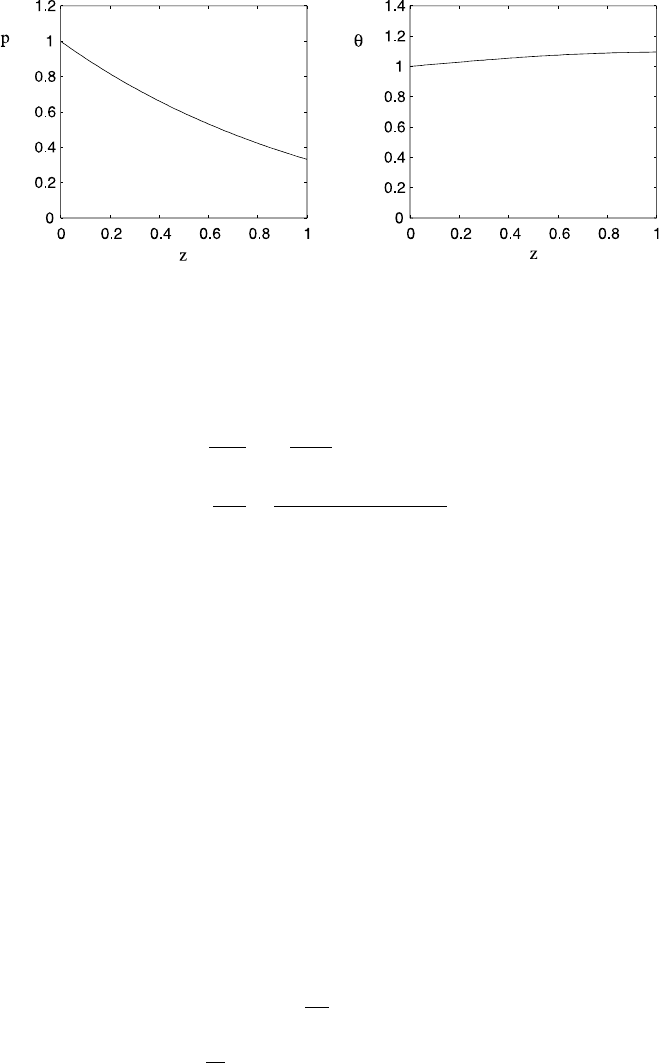Fowler A. Mathematical Geoscience
Подождите немного. Документ загружается.


150 3 Oceans and Atmospheres
where
f
x
=
F
φ
ρ
,f
y
=
F
λ
ρ
,f
z
=
F
r
ρ
. (3.36)
Following (3.4), we take the vector f =(f
x
,f
y
,f
z
) as
f =Fu, (3.37)
where
F =ε
H
∇
2
H
+ε
V
∂
2
∂z
2
, (3.38)
and
∇
H
=
∂
∂x
,
∂
∂y
. (3.39)
3.2.5 Non-dimensionalisation
There are three obvious length scales of immediate relevance. These are the depth
h of the troposphere, the radius r
0
of the Earth, and the length scale l of horizontal
atmospheric motions. We have h = 10 km, r
0
= 6370 km, and the largest (synop-
tic) scales of mid-latitude weather systems are observed to be l = 1000 km. These
lengths combine to form two dimensionless parameters,
δ =
h
l
,Σ=
l
r
0
(3.40)
both of which are small: δ ≈0.01, Σ ≈0.16. The ideas of lubrication theory, using
the fact that δ 1, suggest that in the vertical momentum equation,
∂p
∂z
≈−ρg, i.e.,
the pressure is approximately hydrostatic, as in our basic state. Lubrication theory
also suggests that if U is a suitable horizontal velocity scale, then the appropriate
vertical velocity scale is hU/l, in order that the material derivative retains vertical
acceleration.
Sphericity in the equations is manifested by the terms in 1/r and the trigonomet-
ric terms in λ.Thetermsin1/r are generally small, of order Σ or less, and serve as
a regular perturbation to the Cartesian derivative terms, except near the poles, where
tanλ →∞and a different discussion is necessary.
We scale the variables as follows:
x,y ∼l, z ∼h, u, v ∼U, w ∼δU,
t ∼
l
U
,ρ∼ρ
0
,p∼p
0
,T∼T
0
,
(3.41)
where we choose
p
0
=
ρ
0
RT
0
M
a
=ρ
0
gh (3.42)

3.2 The Geostrophic Circulation 151
(which actually defines h as the (dry) atmospheric scale height, cf. Question 3.2).
The length scales l and r
0
are those we have described, the horizontal wind speed
U is typically about 20 m s
−1
, and the density and temperature scales ρ
0
and T
0
are
their values at sea level. (These are determined by the mass of the atmosphere and
the effective radiative temperature.) For the moment we assume they are constant.
This is a reasonable approximation for p
0
but less so for temperature.
We then have dimensionless expressions
∇. u =μ
∂u
∂x
+
1
cosλ
∂(vcos λ)
∂y
+
∂w
∂z
+δΣ
x
∂w
∂x
+y
∂w
∂y
+2w
,
d
dt
=
∂
∂t
+u .∇ =
∂
∂t
+μu
∂
∂x
+v
∂
∂y
+w
∂
∂z
+δΣw
x
∂
∂x
+y
∂
∂y
,
(3.43)
and the momentum equations take the dimensionless form
Ro
du
dt
−v
sin λ +
1
2
Ro Σvtan λ
+δw
cosλ +
1
2
Ro Σu
=−
Ro
F
2
μ
ρ
∂p
∂x
+f
∗
x
,
Ro
dv
dt
+u
sin λ +
1
2
Ro Σutanλ
+
1
2
δRo Σvw =−
Ro
F
2
1
ρ
∂p
∂y
+f
∗
y
,
δ
δRo
dw
dt
−u cos λ −Ro Σ
u
2
+v
2
=−
Ro
F
2
1
ρ
∂p
∂z
+δΣ
x
∂p
∂x
+y
∂p
∂y
+1
+δf
∗
z
,
(3.44)
in which
λ =λ
0
+Σy, (3.45)
f
∗
k
=
f
k
2ΩU
for k =x, y, z, (3.46)
and the extra parameters are a form of the Rossby number,
Ro =
U
2Ωl
, (3.47)
and the Froude number
F =
U
√
gh
. (3.48)
For U = 20 m s
−1
, Ω = 0.7 × 10
−4
s
−1
, l = 10
3
km, g = 10 m s
−2
, h = 10 km,
we have Ro ≈ 0.14, F ≈ 0.06, and thus F
2
/Ro ≈ 0.03. Evidently the pressure is
essentially hydrostatic, as we expect for a shallow flow.

152 3 Oceans and Atmospheres
The energy equation is commonly written in terms of the potential temperature,
defined as
θ =T
p
0
p
R/M
a
c
p
; (3.49)
the usefulness of this variable lies in the fact that
ρc
p
T
dθ
θ
=ρc
p
dT −dp, (3.50)
so that θ is constant for the dry adiabatic basic state of Question 3.2.
8
If we scale θ
as well as T with T
0
, then the dimensionless definition of θ is
θ =
T
p
α
, (3.51)
in which
α =
R
M
a
c
p
. (3.52)
The equation of state is simply
ρ =
p
T
. (3.53)
The dimensionless energy equation takes the form
p
θ
dθ
dt
=
1
Pe
∂
∂z
k
∗
∂T
∂z
+O
δ
2
+Q
∗
a
+C
∗
; (3.54)
the reduced Péclet number, internal heating rate and condensation rate are given by
Pe =
Uh
2
κ
0
l
,Q
∗
a
=
Q
a
l
ρ
0
c
p
T
0
U
,C
∗
=
LClρ
c
p
T
0
U
, (3.55)
where we have written
¯
k =k
0
k
∗
(k
∗
=O(1)), (3.56)
and
κ
0
=
k
0
ρ
0
c
p
. (3.57)
8
Thus s =c
p
lnθ ,wheres is entropy.

3.2 The Geostrophic Circulation 153
3.2.6 Day and Night, Land and Ocean
The thermal boundary condition at the ground is a flux condition as given in (3.12)
and (3.14). In dimensionless terms, the heat flux is
−k
∗
∂T
∂z
=q
∗
0
at z =0, (3.58)
where
q
∗
0
=
q
0
h
k
0
T
0
. (3.59)
The heat flux scale k
0
T
0
/h ≈ 10
4
Wm
−2
(see Sect. 3.2.7 below), while the com-
bined radiative and sensible heat flux from the ground is q
0
≈ 102 W m
−2
. Thus
q
∗
0
≈ 0.01, and is very small. Equally, the heat flux through the tropopause is very
small. The point is that the time scale of response of the energy balance of the at-
mosphere is much longer, O(10
7
) seconds, than the shorter response time of atmo-
spheric dynamics, l/U ∼ 10
5
seconds. In this sense, the energy of the atmosphere
is like the water in a bath, being filled by a tap and emptied through the plug hole.
The source and sink are small, and control the amount of water in the bath over a
long time scale, while the dynamics of the motion have a much faster time scale.
There is a fundamental distinction between land and ocean, and between day
and night. In the ocean, the temperature must remain at or below the saturation
temperature and above the freezing temperature. At saturation, the thermal boundary
condition (3.14) determines the rate of evaporation; the thermal boundary condition
is that T = T
sat
, the saturation temperature. If T<T
sat
, then E = 0 and the sea
surface temperature is set by the incoming radiation, as we must have
σT
4
=q
0
=q
s
+q
−
. (3.60)
The same is true on land, except that since evaporation is essentially absent, the
surface temperature is always determined by incoming short wave radiation.
Evidently, it is cold at night and warm in the day. At sea, evaporation switches
on in the daytime. As the moist air is brought by the circulation over the warm
land, it rises and thus forms clouds through condensation at higher (thus cooler)
altitudes. The clouds we see scudding across the sky are the tops of convective
plumes weaving their way across the countryside. This is why it always rains in
Seattle, for example.
9
I live in the Thames valley, say 100 km east of Bristol, perhaps 200 km from the
sea. At that distance a wind of 20 m s
−1
takes 10
4
s, about three hours, to make its
way from the sea. And indeed, it is commonly the case on a Sunday morning that
the skies are clear in the early morning, but by mid-morning it has clouded over.
This is why.
9
The effect is worsened by the topographic effect of the coastal mountain range.

154 3 Oceans and Atmospheres
3.2.7 Parameter Estimates
We have already estimated typical values δ ≈0.01, Ro ≈0.14, F ≈0.06, Σ ≈0.16,
and we need further to estimate values of f
∗
k
, Pe, Q
∗
a
and C
∗
. We estimate the
internal radiative heating Q
a
h ∼ 0.2q
i
∼ 68 W m
−2
; using values ρ ≈ 1kgm
−3
,
h ≈ 10 km, c
p
≈ 10
3
Jkg
−1
K
−1
, l = 10
3
km, T
0
= 288 K, U = 20 m s
−1
,we
obtain Q
∗
a
∼ 1.2 × 10
−3
. Internal radiative heating is therefore very small: this is
consistent with the discussion concerning thermal boundary conditions above.
In order to estimate Pe and f
∗
k
, we need estimates of eddy viscosities. A typ-
ical estimate in the horizontal is ε
H
∼ 0.1Uh ∼ 10
4
m
2
s
−1
, and a typical esti-
mate in the vertical is ε
V
∼ 0.1δUh ∼ 10
2
m
2
s
−1
. Therefore ε
H
∇
2
H
∼ 10
−8
s
−1
,
ε
V
∂
2
/∂z
2
∼ 10
−6
s
−1
, so that the vertical diffusivity is dominant. Then f
∗
x,y
∼
ε
V
/2Ωh
2
∼10
−2
, while f
∗
z
∼δf
∗
x,y
.
We already estimated Pe ∼ 20 in Question 2.10, based on a radiative effective
thermal conductivity of k
R
≈ 10
5
Wm
−1
K
−1
. A corresponding estimate for the
(vertical) eddy thermal conductivity is k
T
≈ρc
p
ε
V
≈10
5
Wm
−1
K
−1
, comparable
to the radiative value. This suggests that
¯
k ∼k
0
≈2 ×10
5
Wm
−1
K
−1
is a reason-
able estimate, which would then suggest that Pe ∼10.
In order to estimate the dimensionless condensation rate C
∗
,weuse(3.15). The
eddy diffusive term is small relative to the advective term (the ratio is of order
ε
V
l/Uh
2
∼0.05), and is only of concern within the planetary boundary layer, so we
can take C ≈−dm/dt, assuming saturation. We use the formula in Question 2.12
for p
SV
,
p
SV
=p
0
SV
exp
a
1 −
T
0
T
, (3.61)
where
a =
M
v
L
RT
0
. (3.62)
Appropriate values are a ≈18.8 and p
0
SV
≈1,688 Pa.
10
From these we find
m =
M
v
p
0
SV
M
a
p
exp
a
1 −
T
0
T
, (3.63)
and in terms of the dimensionless temperature and pressure,
m =νM(T , p), (3.64)
10
This is different from the triple point value of 600 Pa because we use 288 K as the reference
temperature, not 273 K.

3.2 The Geostrophic Circulation 155
where
11
M(T,p) =
1
p
exp
a
1 −
1
T
, (3.65)
and
ν =
M
v
p
0
SV
M
a
p
0
. (3.66)
Approximately, ν ≈0.01. In dimensionless terms, we thus have
C
∗
=νSt
−ρ
dM
dt
, (3.67)
where the Stefan number is
St =
L
c
p
T
0
. (3.68)
The value of St is 8.7, so that νSt ≈ 0.087. Because a is large and M is O(1),
dM/dt ∼aM, and thus C
∗
∼O(1) (the value of νSt a is ≈1.6).
3.2.8 Basic Reference State
Using the definitions of M in (3.65), and of ρ and T in (3.53) and (3.51), we can
write the energy equation (3.54) in the form
p
θ
1 +
νSt aM
T
2
dθ
dt
=−
νSt M(αa −T)
T
2
dp
dt
+
1
Pe
∂
∂z
k
∗
∂T
∂z
, (3.69)
in which we neglect Q
∗
a
and O(δ
2
Pe).
If we further neglect the conductive term of O(1/Pe), then to leading order,
(3.44) and (3.69) can be written as
∂p
∂z
=−ρ,
p
θ
1 +
νSt aM
T
2
dθ
dt
=−
νSt M(αa −T)
T
2
dp
dt
, (3.70)
representing a wet adiabatic hydrostatically balanced atmosphere. This tells us that
in such an atmosphere, θ is a well-defined function of p, and hence (because of
hydrostatic balance) also of z. We define this basic wet potential temperature func-
tion as θ
w
(p), and the corresponding pressure and density profiles as p
w
and ρ
w
.
11
This definition of M should not be confused with its use as the tropospheric latent heat term in
(3.24), which we no longer have use for.

156 3 Oceans and Atmospheres
Fig. 3.1 Solution of (3.71). The pressure is excellently approximated by p ≈ e
−1.08z
,andthe
potential temperature is excellently approximated by θ ≈ 1 +0.15z −0.05z
2
Thus θ
w
and p
w
are determined by solving the simultaneous differential equations
(noting that ρ =p
1−α
/θ and T =θp
α
)
dp
w
dz
=−
p
1−α
w
θ
w
,
dθ
w
dz
=
νSt (aα −θ
w
p
α
w
)M
[θ
2
w
p
2α
w
+νSt aM]p
α
w
,
(3.71)
with p
w
=θ
w
=1atz =0. We have α ≈0.29, a ≈ 18.8, and thus αa ≈ 5.45, and
so dθ
w
/dz > 0. Also ν ≈0.01, St ≈8.7, so that νSt ≈0.087, and the potential tem-
perature gradient appears on this basis to be small, of O(Ro). Figure 3.1 shows a
numerical solution of (3.71), which shows that pressure decreases approximately
exponentially (with scale height of about 10 km) and θ
w
increases approximately
linearly, in this model. The numerical solution indicates that the potential temper-
ature gradient is indeed small, of order 0.1. We associate this with the fact that
νSt ≈ 0.087 is small. Below, we define a parameter ε (the Rossby number) which
is of the same order as the wet potential temperature gradient; then θ
w
=1 +O(ε)
defines a wet adiabat, whereas a dry reference state in which the moisture term is
absent is simply θ = 1. Reality is somewhere between the two, though nearer the
wet state.
3.2.9 A Reduced Model
In order to approximate the model, we note that
δ ∼RoΣ ∼
F
2
Ro
∼f
∗
x,y
∼10
−2
,
1
Pe
∼νSt ∼Ro ∼Σ ∼10
−1
,
(3.72)

3.2 The Geostrophic Circulation 157
and the other parameters Q
∗
a
and f
∗
z
are much smaller. These suggest that we should
think of 1/Pe, νSt, Ro and Σ as small, but an order of magnitude larger than δ and
F
2
/Ro. In fact, ∂T/∂z ∼ α, and α/Pe ≈0.04; therefore we shall consider the con-
ductive term in (3.69)tobeofO(δ) (see also Question 3.3). In fact, to be specific,
we now define the length scale l and velocity scale U by requiring that
F
2
sin λ
0
Ro
=
α
Pe
=ε
2
, (3.73)
where it is conventional to define the Rossby number as
ε =
Ro
sin λ
0
=
U
fl
, (3.74)
in which the Coriolis parameter f is defined as
f =2Ω sin λ
0
. (3.75)
This leads to definitions
U =
ακ
0
g
fh
1/2
,l=U
h
2
ακ
0
f
2
1/3
, (3.76)
and calculation of these using values used previously leads to U ≈ 26 m s
−1
, l ≈
1290 km.
Next, we adopt the formal asymptotic limits
νSt ∼Ro ∼Σ ∼ε,
δ ∼RoΣ ∼f
∗
x,y
∼ε
2
.
(3.77)
Expanding the equations in powers of ε, the vertical momentum equation is
∂p
∂z
≈−ρ +O
ε
3
, (3.78)
where
ρ =
p
T
,θ=
T
p
α
. (3.79)
Also,
∇. u ≈μ
∂u
∂x
+μ
∂(v/μ)
∂y
+
∂w
∂z
+O
ε
3
,
d
dt
=
∂
∂t
+u .∇ ≈
∂
∂t
+μu
∂
∂x
+v
∂
∂y
+w
∂
∂z
+O
ε
3
,
(3.80)

158 3 Oceans and Atmospheres
the horizontal momentum equations are approximately
ε sin λ
0
du
dt
−v sin λ =−
sin λ
0
ε
2
μ
ρ
∂p
∂x
+O
ε
2
,
ε sin λ
0
dv
dt
+u sin λ =−
sin λ
0
ε
2
1
ρ
∂p
∂y
+O
ε
2
,
(3.81)
and the energy equation is approximately
p
θ
1 +
νSt aM
T
2
dθ
dt
=−
εsM(αa −T)
T
2
dp
dt
+ε
2
∂
∂z
k
∗
α
∂T
∂z
, (3.82)
where we have written
νSt =εs (3.83)
to delineate the smallness of νSt (but noting that νSt a ≈1.64 is O(1)). Together
with the conservation of mass equation
dρ
dt
+ρ∇. u =0, (3.84)
this completes the basic approximate model, valid locally everywhere except near
the poles (where μ and tanλ →∞). There are seven equations in (3.78), (3.79),
(3.81), (3.82) and (3.84) for the seven variables θ, ρ, T , p, u, v and w. The frictional
terms f
∗
x,y
can be neglected in the main flow, but they are important in the planetary
boundary layer, as we discuss later.
3.2.10 Geostrophic Balance
Geostrophic flow is described by the leading order approximation which considers
both curvature and inertial effects to be small, that is, ε 1. At leading order, the
pressure is hydrostatic, and (3.81) indicates that the correction is of O(ε
2
).This
is consistent with (3.82), which indicates that θ =
¯
θ(z) + O(ε
2
). We do not yet
assume that
¯
θ is equal to the reference state θ
w
defined in (3.71); this would have to
be deduced. But we do anticipate that
¯
θ
(z) =O(ε) (since also θ
w
=O(ε)). We put
p =¯p(z) +ε
2
P, (3.85)
where ¯p is the hydrostatic pressure corresponding to
¯
θ, and we denote the corre-
sponding density and temperature as ¯ρ and
¯
T . Then, since μ ≈1, λ ≈λ
0
and ρ ≈¯ρ,
the momentum equations become
¯ρv ≈
∂P
∂x
,
¯ρu ≈−
∂P
∂y
,
(3.86)

3.3 The Planetary Boundary Layer 159
and mass conservation reduces to
∂( ¯ρu)
∂x
+
∂( ¯ρv)
∂y
+
∂( ¯ρw)
∂z
≈0. (3.87)
Together (3.86) and (3.87)imply
∂( ¯ρw)
∂z
=0, (3.88)
and thus w is determined by its value on the surface, where it is prescribed by the
no flow-through boundary condition. In the absence of topography, we have w =0
at z = 0, so that w = 0 everywhere. The flow is purely two-dimensional, and the
horizontal velocity vector u
H
=(u, v) is given by
¯ρu
H
=k ×∇
H
P, (3.89)
where ∇
H
=(
∂
∂x
,
∂
∂y
).(3.89) defines the geostrophic wind, and shows that
u
H
.∇
H
p = 0, i.e., wind velocities are along isobars. In the northern hemisphere,
the wind moves anti-clockwise about regions of low pressure (depressions, or cy-
clones). The closer the isobars, the higher the wind speed.
3.3 The Planetary Boundary Layer
By neglecting the frictional terms in (3.29), we are unable to satisfy the condition
of no slip at the Earth’s surface. We now reconsider these terms in order to see
how this condition can be met. Although the frictional terms are small, they become
important in the planetary boundary layer, a layer with a depth of about a kilometre
adjoining the surface.
Following (3.37) and (3.46), we add the dimensionless friction terms to (3.81),
to obtain
−v =−
1
¯ρ
∂P
∂x
+E
∂
2
u
∂z
2
+O(ε),
u =−
1
¯ρ
∂P
∂y
+E
∂
2
v
∂z
2
+O(ε),
(3.90)
where the Ekman number is given by
E =
ε
V
fh
2
. (3.91)
With f ∼10
−4
s
−1
, ε
V
∼10
2
ms
−1
, h ∼10
4
m, we have E ∼10
−2
∼ε
2
as previ-
ously stated.
The frictional terms are indeed negligible, except in a boundary layer of thickness
ε, in which we rescale
z =εZ, w =εW, (3.92)
